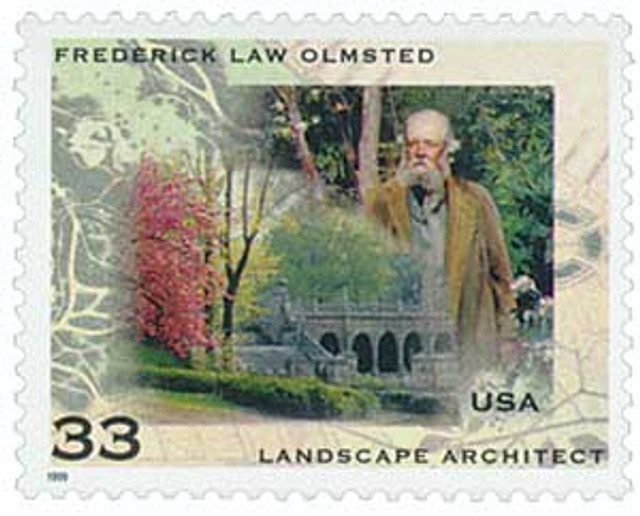
Frederick Law Olmsted was born on April 26, 1822, in Hartford, Connecticut. He’s considered the father of American landscape architecture. Some of his most well-known projects include New York’s Central and Prospect Parks as well as the US Capitol building grounds.
Olmsted and his brother John shared a love of nature and travel instilled by their father. Olmsted planned to attend Yale College, but suffered from sumac poisoning that weakened his eyes. He worked as a seaman and a merchant before establishing a farm in Staten Island, New York in 1848. He also had a successful career in journalism that enabled him to travel to Europe. His time there inspired Walks and Talks of an American Farmer in England. He also visited Birkenhead Park, which would eventually provide inspiration for his Central Park design. Olmsted then spent five years traveling through the American South to research and write about the economic impact of slavery. His writings were later collected into three volumes.
In 1858, a contest was held to determine the design of Central Park, America’s first great urban park. The plan submitted by Olmsted and architect Calvert Vaux, titled “Greensward,” won. Within a few years, they turned the 843 acres into a beautiful landscape, complete with recreation areas and lush scenery. Olmsted was a visionary who foresaw the day when America’s urban areas would become crowded and complex. He recognized the need to preserve and adapt the green, open land of the cities for the recreation of those who lived there. As a result of his deep love for the land, Olmsted fathered the profession of landscape architecture in America.
During the Civil War, Olmsted took a break from his work as director of Central Park to serve as executive secretary of the US Sanitary Commission. He helped organize a Sanitary Fair that raised $1 million and recruited three regiments of the US Colored Troops. Olmsted worked tirelessly for the commission for two years to the point of exhaustion and resigned in 1863. Within a month, however, he headed to California to manage the Rancho Las Mariposas-Mariposa gold mining operation, though the mine proved unsuccessful.
Olmsted returned to New York in 1865 and formed Olmsted, Vaux & Co. Together they designed New York’s Prospect Park and Chicago’s Riverside parks. They also designed the Niagara Reservation in New York, America’s oldest state park. In addition to city parks, they designed a handful of park systems and parkways connecting cities to green areas. These included park systems for Buffalo, New York, Milwaukee, Wisconsin, and Louisville, Kentucky. Olmsted also designed the grounds for the Buffalo State Asylum and Hudson River State Hospital. Along with dozens of other parks around the country, Olmsted designed the Midway for the 1893 World’s Columbian Exposition, the University of Chicago campus, and the grounds of the US Capitol building.
With his love of nature, Olmsted was also an early leader in the conservation movement. He supported the protection of Yosemite Valley and served on its board of commissioners. His 1865 report on the area shaped how the government set aside public lands to protect their “value to posterity.” Olmsted worked to protect the natural features at Niagara Falls and in New York’s Adirondack region. He even turned down park projects if he felt they were inappropriate, in one case saying that it “should not be marred by the intrusion of artificial objects.”

Olmsted’s health began to decline in 1895, forcing him to retire. He spent his final years in Belmont, Massachusetts before his death on August 28, 1903. His sons carried on the family firm and it remained in business until 1980. One of Olmsted’s friends once said he was, “An artist, he paints with lakes and wooded slopes; with lawns and banks and forest covered hills; with mountain sides and ocean views.”
You can also explore the work of Olmsted’s firm through this neat interactive map.
| FREE printable This Day in History album pages Download a PDF of today’s article. Get a binder or other supplies to create your This Day in History album. |
Discover what else happened on This Day in History.





He was also the architect for the fauna design at the Biltmore Estate in Asheville, NC. Truly lovely and magnificent grounds.
My wife and I have talked about the Biltmore Estate. Maybe we’ll actually get there to see it!